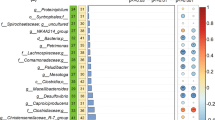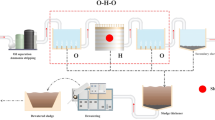Abstract
For comprehensive insights into the influences of sulfate on performance, microbial community and metabolic pathways in the acidification phase of a two-phase anaerobic system, a laboratory-scale acidogenic bioreactor was continuously operated to treat wastewater with elevated sulfate concentrations from 2000 to 14000 mg/L. The results showed that the acidogenic bioreactor could achieve sulfate reduction efficiency of greater than 70% for influent sulfate content less than 12000 mg/L. Increased sulfate induced the accumulation of volatile fatty acids (VFAs), especially propionate and butyrate, which was the primary negative effects to system performance under the high-sulfate environment. High-throughput sequencing coupled with PICRUSt2 uncovered that the accumulation of VFAs was triggered by the decreasing of genes encoding short-chain acyl-CoA dehydrogenase (EC: 1.3.8.1), regulating the transformation of propanoyl-CoA to propenoyl-CoA and butanoyl-CoA to crotonyl-CoA of propionate and butyrate oxidation pathways, which made these two process hardly proceed. Besides, genes encoding (EC: 1.3.8.1) were mainly carried by order Clostridiales. Desulfovibrio was the most abundant sulfate-reducing bacteria and identified as the primary host of dissimilatory sulfate reduction functional genes. Functional analysis indicated the dissimilatory sulfate reduction process predominated under a low sulfate environment, but was not favored under the circumstance of high-sulfate. With the increase of sulfate, the assimilatory sulfate reduction process finally overwhelmed dissimilatory as the dominant sulfate reduction pathway in acidogenic bioreactor.

Similar content being viewed by others
Reference
An Q, Cheng J R, Wang Y T, Zhu M J (2020). Performance and energy recovery of single and two stage biogas production from paper sludge: Clostridium thermocellum augmentation and microbial community analysis. Renewable Energy, 148: 214–222
Baquiran J I P, Nada M A L, Posadas N, Manogan D P, Cabaitan P C, Conaco C (2020). Population structure and microbial community diversity of two common tetillid sponges in a tropical reef lagoon. PeerJ, 8: e9017
Caicedo H H, Hashimoto D A, Caicedo J C, Pentland A, Pisano G P (2020). Overcoming barriers to early disease intervention. Nature Biotechnology, 38(6): 669–673
Dhar B R, Park J H, Park H D, Lee H S (2019). Hydrogen-based syntrophy in an electrically conductive biofilm anode. Chemical Engineering Journal, 359: 208–216
Esquivel-Elizondo S, Parameswaran P, Delgado A G, Maldonado J, Rittmann B E, Krajmalnik-Brown R (2016). Archaea and bacteria acclimate to high total ammonia in a methanogenic reactor treating swine waste. Archaea (Vancouver, B.C.), 2016: 4089684
Gil-Garcia C, de Godoi L A G, Fuess L T, Damianovic M H R Z (2018). Performance improvement of a thermophilic sulfate-reducing bioreactor under acidogenic conditions: Effects of diversified operating strategies. Journal of Environmental Management, 207: 303–312
Han G, Shin S G, Cho K, Lee J, Kim W, Hwang S (2019). Temporal variation in bacterial and methanogenic communities of three full-scale anaerobic digesters treating swine wastewater. Environmental Science and Pollution Research International, 26(2): 1217–1226
Jang H M, Ha J H, Park J M, Kim M S, Sommer S G (2015). Comprehensive microbial analysis of combined mesophilic anaerobic-thermophilic aerobic process treating high-strength food waste-water. Water Research, 73: 291–303
Khanal S K, Huang J C (2005). Effect of high influent sulfate on anaerobic wastewater treatment. Water Environment Research: A Research Publication of the Water Environment Federation, 77(7): 3037–3046
Langille M G I, Zaneveld J, Caporaso J G, McDonald D, Knights D, Reyes J A, Clemente J C, Burkepile D E, Vega Thurber R L, Knight R, Beiko R G, Huttenhower C (2013). Predictive functional profiling of microbial communities using 16S rRNA marker gene sequences. Nature Biotechnology, 31: 814–821
Lee S H, Park J H, Kang H J, Lee Y H, Lee T J, Park H D (2013). Distribution and abundance of Spirochaetes in full-scale anaerobic digesters. Bioresource Technology, 145: 25–32
Li B, Yang Y, Ma L, Ju F, Guo F, Tiedje J M, Zhang T (2015). Metagenomic and network analysis reveal wide distribution and cooccurrence of environmental antibiotic resistance genes. The ISME Journal, 9(11): 2490–2502
Li J, Cai M H, Miao Y, Luo G, Li W T, Li Y, Li A M (2019a). Bacterial community structure and predicted function in an acidogenic sulfate-reducing reactor: Effect of organic carbon to sulfate ratios. Bioresource Technology, 293: 122020
Li J, Li W T, Luo G, Li Y, Li A M (2019b). Effect of nitrobenzene on the performance and bacterial community in an expanded granular sludge bed reactor treating high-sulfate organic wastewater. Frontiers of Environmental Science & Engineering, 13(1): 6
Li J, Liang Y, Miao Y, Wang D, Jia S, Liu C H (2020). Metagenomic insights into aniline effects on microbial community and biological sulfate reduction pathways during anaerobic treatment of high-sulfate wastewater. Science of the Total Environment, 742: 140537
Li R, Zhou M, He S, Pan T, Liu J, Zhu J (2021). Deciphering the effect of sodium dodecylbenzene sulfonate on up-flow anaerobic sludge blanket treatment of synthetic sulfate-containing wastewater. Frontiers of Environmental Science & Engineering, 15: 91
Linz A M, He S, Stevens S L R, Anantharaman K, Rohwer R R, Malmstrom R R, Bertilsson S, McMahon K D (2018). Freshwater carbon and nutrient cycles revealed through reconstructed population genomes. PeerJ, 6: e6075
Luo G, Karakashev D, Xie L, Zhou Q, Angelidaki I (2011). Long-term effect of inoculum pretreatment on fermentative hydrogen production by repeated batch cultivations: Homoacetogenesis and methanogenesis as competitors to hydrogen production. Biotechnology and Bioengineering, 108(8): 1816–1827
Luo L, Kaur G, Wong J W C (2019). A mini-review on the metabolic pathways of food waste two-phase anaerobic digestion system. Waste management & research: the journal of the International Solid Wastes and Public Cleansing Association, ISWA, 37(4): 333–346
Ma L, Xia Y, Li B, Yang Y, Li L G, Tiedje J M, Zhang T (2016). Metagenomic assembly reveals hosts of antibiotic resistance genes and the shared resistome in pig, chicken, and human feces. Environmental Science & Technology, 50(1): 420–427
Müller N, Worm P, Schink B, Stams A J M, Plugge C M (2010). Syntrophic butyrate and propionate oxidation processes: from genomes to reaction mechanisms. Environmental Microbiology Reports, 2(4): 489–499
Ozkan J, Willcox M, Wemheuer B, Wilcsek G, Coroneo M, Thomas T (2019). Biogeography of the human ocular microbiota. The Ocular Surface, 17(1): 111–118
Ren N Q, Chua H, Chan S Y, Tsang Y F, Sin N (2007). Effects of COD/SO42− ratios on an acidogenic sulfate-reducing reactor. Industrial & Engineering Chemistry Research, 46(6): 1661–1666
Shan L, Zhang Z, Yu Y, Ambuchi J J, Feng Y (2017). Performance of CSTR-EGSB-SBR system for treating sulfate-rich cellulosic ethanol wastewater and microbial community analysis. Environmental Science and Pollution Research International, 24(16): 14387–14395
Stams A J M, Plugge C M, de Bok F A M, van Houten B H G W, Lens P, Dijkman H, Weijma J (2005). Metabolic interactions in methanogenic and sulfate-reducing bioreactors. Water science and technology: A journal of the International Association on Water Pollution Research, 52(1–2): 13–20
Wang P, Qiao Z, Li X, Su Y, Xie B (2020). Functional characteristic of microbial communities in large-scale biotreatment systems of food waste. Science of the Total Environment, 746: 141086
Wei C H, Wang W X, Deng Z Y, Wu C F (2007). Characteristics of high-sulfate wastewater treatment by two-phase anaerobic digestion process with Jet-loop anaerobic fluidized bed. Journal of Environmental Sciences (China), 19(3): 264–270
Xu Y, Gong H, Dai X (2021). High-solid anaerobic digestion of sewage sludge: Achievements and perspectives. Frontiers of Environmental Science & Engineering, 15(4):71
Yang S, Li J, Zheng Z, Meng Z (2009). Characterization of Spartina alterniflora as feedstock for anaerobic digestion. Biomass and Bioenergy, 33(4): 597–602
Yuan Y, Chen C, Liang B, Huang C, Zhao Y, Xu X, Tan W, Zhou X, Gao S, Sun D, Lee D, Zhou J, Wang A (2014). Fine-tuning key parameters of an integrated reactor system for the simultaneous removal of COD, sulfate and ammonium and elemental sulfur reclamation. Journal of Hazardous Materials, 269: 56–67
Zhang X, Zhang L, Zhang L, Ji Z, Shao Y, Zhou H, Bao Y, Qu Y, Liu L (2019). Comparison of rhizosphere bacterial communities of reed and Suaeda in Shuangtaizi River Estuary, Northeast China. Marine Pollution Bulletin, 140: 171–178
Zhang Z Y, Ali M W, Saqib H S A, Liu S X, Yang X, Li Q, Zhang H (2020). A shift pattern of bacterial communities across the life stages of the citrus red mite, Panonychus citri. Frontiers in Microbiology, 11
Acknowledgements
We gratefully acknowledge generous support provided by the National Natural Science Foundation of China (No. 51978328). We thank LetPub (www.letpub.com) for its linguistic assistance during the preparation of this manuscript.
Author information
Authors and Affiliations
Corresponding author
Additional information
Highlights
• Over 70% reduction of sulfate was achieved for sulfate less than 12000 mg/L.
• The decrease of genes encoding (EC: 1.3.8.1) induced the accumulation of VFAs.
• The sulfate reduction genes were primary carried by genus Desulfovibrio.
• Sulfate favored assimilatory, but inhibited dissimilatory sulfate reduction process.
Rights and permissions
About this article
Cite this article
Li, J., Li, A., Li, Y. et al. PICRUSt2 functionally predicts organic compounds degradation and sulfate reduction pathways in an acidogenic bioreactor. Front. Environ. Sci. Eng. 16, 47 (2022). https://doi.org/10.1007/s11783-021-1481-8
Received:
Revised:
Accepted:
Published:
DOI: https://doi.org/10.1007/s11783-021-1481-8




